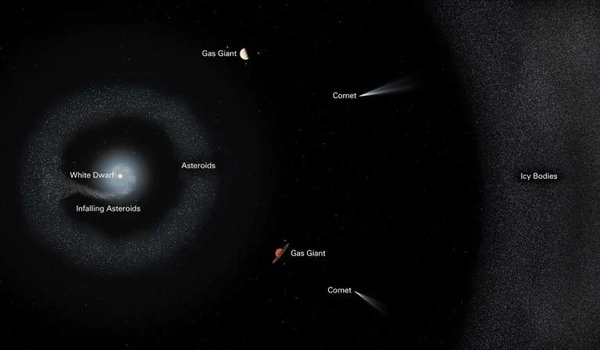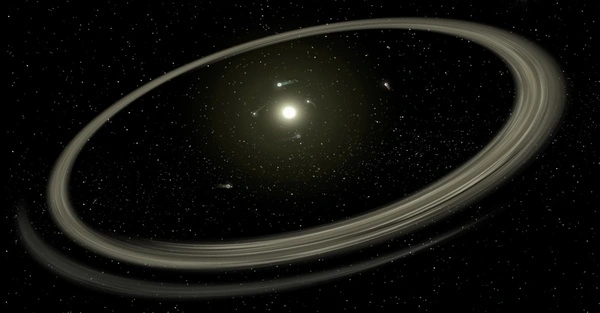A nearby star’s violent death throes so thoroughly disrupted its planetary system that the dead star left behind, known as a white dwarf, is sucking in debris from both the system’s inner and outer reaches, UCLA astronomers and colleagues report today.
This is the first instance of cosmic cannibalism in which astronomers have observed a white dwarf consuming both rocky-metallic material, most likely from a nearby asteroid, and icy material, thought to be from a body similar to those found in our own solar system’s Kuiper belt.
“We’ve never seen both of these kinds of objects accreting onto a white dwarf at the same time,” said lead researcher Ted Johnson, a UCLA physics and astronomy major who graduated last week. “By studying these white dwarfs, we hope to gain a better understanding of planetary systems that are still intact.”
The findings are based on an analysis of materials captured by the atmosphere of G238-44, a white dwarf 86 light-years from Earth, using archival data from the Hubble Space Telescope and other NASA satellites and observatories. A white dwarf is the burned-out core that remains after a star, such as our sun, sheds its outer layers and stops burning fuel through nuclear fusion.
As surprising as the white dwarf’s diverse diet is, the findings are also intriguing because astronomers believe icy objects collided with and irrigated dry, rocky planets in our solar system, including Earth. Comets and asteroids are thought to have delivered water to our planet billions of years ago, sparking the conditions for life. According to UCLA physics and astronomy professor Benjamin Zuckerman, the composition of the material detected raining onto G238-44 suggests that icy reservoirs may be common among planetary systems.
We’ve never seen both of these kinds of objects accreting onto a white dwarf at the same time. By studying these white dwarfs, we hope to gain a better understanding of planetary systems that are still intact.
Ted Johnson
“Life as we know it requires a rocky planet covered with a variety of volatile elements like carbon, nitrogen and oxygen,” Zuckerman said. “The abundances of the elements we see on this white dwarf appear to have come from both a rocky parent body and a volatile-rich parent body — the first example we’ve found among studies of hundreds of white dwarfs.”
Chaos and destruction: From living star to red giant to white dwarf
According to planetary-system evolution theories, a star’s demise is a turbulent, chaotic event that begins when it first balloons exponentially into what is known as a red giant and then quickly loses its outer layers, collapsing into a white dwarf – a super-dense star about the size of Earth and with the mass of our sun. The process significantly disrupts the orbits of the remaining planets, and smaller objects such as asteroids, comets, and moons that come too close to them can be scattered like pinballs and sent hurtling toward the white dwarf.
This study confirms the true scale of the chaos, demonstrating that the star can simultaneously capture and consume material from its nearby asteroid belt and its far-flung Kuiper belt-like regions within 100 million years of the start of its white dwarf phase.

Despite the fact that astronomers have catalogued over 5,000 planets outside our solar system, Earth is the only planet whose interior makeup we have some direct knowledge of. Because the materials accreting onto G238-44 are representative of the building blocks of major planets, this white dwarf cannibalism offers a once-in-a-lifetime opportunity to disassemble planets and see what they were made of when they first formed around the star, according to UCLA astronomy researcher Beth Klein, a team member.
The team measured the presence of nitrogen, oxygen, magnesium, silicon, and iron in the white dwarf’s atmosphere, among other elements. According to Johnson, their discovery of iron in extremely high abundance is evidence for metallic cores of terrestrial planets such as Earth, Venus, Mars, and Mercury. Because of the unexpectedly high nitrogen abundances, they concluded that icy bodies were also present.
“A nearly two-to-one mix of Mercury-like material and comet-like material, which is made up of ice and dust, was the best fit for our data,” Johnson said. “Iron metal and nitrogen ice both suggest radically different conditions for planet formation. There is no known solar system object with such a high concentration of both.”
According to the researchers, the ultimate scenario for our own sun in 5 billion years will most likely be very similar to what has been observed with G238-44. They predict that during the sun’s red giant phase, the Earth, along with the inner planets, will be completely vaporized.
Many of the asteroids in our solar system’s main asteroid belt will be gravitationally perturbed by Jupiter and will also fall onto the white dwarf remnant that the sun will become, he said. For more than two years, the UCLA research team has worked with colleagues from UC San Diego and the University of Kiel in Germany to solve the mystery of G238-44 by analyzing the elements detected on the white dwarf star.





